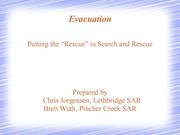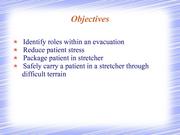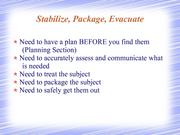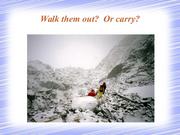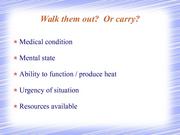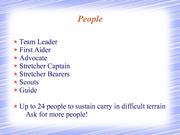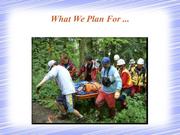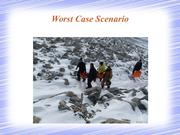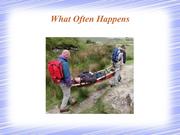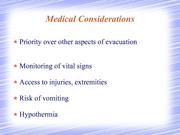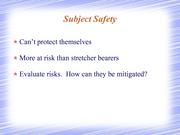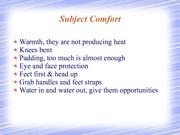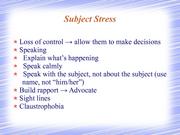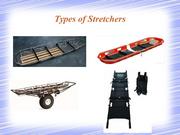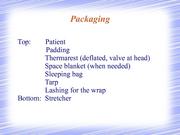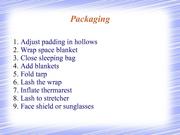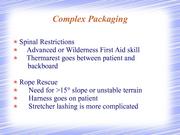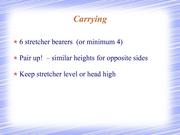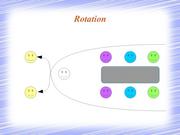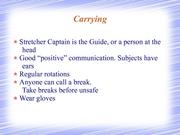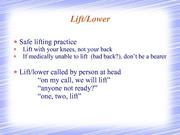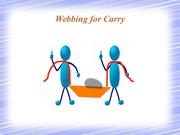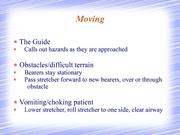SAR Fundamentals/Evacuation
From PCSAR
(→Time Plan) |
(→Time Plan) |
||
| (14 intermediate revisions not shown.) | |||
| Line 1: | Line 1: | ||
| - | + | {{Lesson plan/Header}} | |
| - | + | ||
== Subject == | == Subject == | ||
| + | {{prompt|What is this lesson plan about?}} | ||
Moving the subject after they have been located. | Moving the subject after they have been located. | ||
== Authors == | == Authors == | ||
| - | + | {{prompt|List who wrote this lesson plan.}} | |
== Scope == | == Scope == | ||
{{prompt|What is included in this lesson, what's not and why.}} | {{prompt|What is included in this lesson, what's not and why.}} | ||
| + | : Addresses part of [[Members:CSA/Z1625/Text/Searcher training curriculum/First aid and survival skills/First aid|CSA Z1625 4.4.1]] | ||
| + | :* part of T1. First aid procedures related to relevant search environment. | ||
: SAR Fundamentals Manual: Ch.26 "Evacuation" | : SAR Fundamentals Manual: Ch.26 "Evacuation" | ||
: Basic SAR Skills Manual: Ch.23 "Rescue and Evacuation" | : Basic SAR Skills Manual: Ch.23 "Rescue and Evacuation" | ||
| - | : | + | : include litter carry / patient packaging |
| + | : does not include spinal restriction / C-collar / backboard | ||
== Prerequisites == | == Prerequisites == | ||
| Line 19: | Line 22: | ||
== Objectives == | == Objectives == | ||
At the conclusion of this lesson the participants: | At the conclusion of this lesson the participants: | ||
| - | # | + | # can identify roles within an evacuation |
| + | # can reduce patient stress | ||
| + | # can package patient in stretcher | ||
| + | # can safely carry a patient in a stretcher through terrain difficulties | ||
== Time Plan == | == Time Plan == | ||
| - | Total Time: | + | Total Time: 40 minutes lecture, 30 minute practice |
* 2013-02: 25 min | * 2013-02: 25 min | ||
{{lesson slides start}} | {{lesson slides start}} | ||
{{lesson slide|00:00|3 min}} | {{lesson slide|00:00|3 min}} | ||
| + | [[Image:SAR Basics Evacuation.pdf|page=1|thumb]] | ||
| + | [[Image:SAR Basics Evacuation.pdf|page=2|thumb]] | ||
| + | |||
Introduce topic title | Introduce topic title | ||
| Line 32: | Line 41: | ||
Present Objectives | Present Objectives | ||
| - | {{lesson slide|00:03|}} | + | # can identify roles within an evacuation |
| - | + | # can reduce patient stress | |
| + | # can package patient in stretcher | ||
| + | # can safely carry a patient in a stretcher through terrain difficulties | ||
| + | {{lesson slide|00:03|1 min}} | ||
| + | [[Image:SAR Basics Evacuation.pdf|page=3|thumb]] | ||
| + | [[Image:SAR Basics Evacuation.pdf|page=4|thumb]] | ||
| + | '''Evacuation Concept | ||
| - | '' | + | |
| + | {{lesson slide|00:04|2 min}} | ||
| + | [[Image:SAR Basics Evacuation.pdf|page=5|thumb]] | ||
| + | [[Image:SAR Basics Evacuation.pdf|page=6|thumb]] | ||
| + | ''Carry vs. ... | ||
| + | |||
| + | * helicopter extraction | ||
| + | * stay | ||
| + | |||
| + | {{lesson slide|00:06|3 min}} | ||
| + | [[Image:SAR Basics Evacuation.pdf|page=7|thumb]] | ||
| + | [[Image:SAR Basics Evacuation.pdf|page=8|thumb]] | ||
| + | [[Image:SAR Basics Evacuation.pdf|page=9|thumb]] | ||
| + | [[Image:SAR Basics Evacuation.pdf|page=10|thumb]] | ||
| + | Roles in Evacuation | ||
| + | |||
| + | inner circle (medical) vs. outer circle (rescue) | ||
| + | |||
| + | * team leader | ||
| + | * first aider | ||
| + | * advocate | ||
| + | * stretcher bearers | ||
| + | * scouts | ||
| + | ** scout out entire route | ||
| + | ** avoid having to back track | ||
| + | ** entire route doesn't need to be flagged, but does need to be obvious to the guide | ||
| + | * guide | ||
| + | |||
| + | Additional resources will be sent in | ||
| + | * up to 24 people required to sustain carry of stretcher in difficult terrain | ||
| + | |||
| + | {{lesson slide|00:09|2 min}} | ||
| + | [[Image:SAR Basics Evacuation.pdf|page=11|thumb]] | ||
| + | Medical Considerations | ||
| + | |||
| + | * take priority over most other aspects of evacuation | ||
| + | * continuing monitoring of vital signs | ||
| + | * access to injuries and extremity | ||
| + | * risk of vomiting | ||
| + | * hypothermia | ||
| + | |||
| + | {{lesson slide|00:11|2 min}} | ||
| + | [[Image:SAR Basics Evacuation.pdf|page=12|thumb]] | ||
| + | Subject Safety | ||
| + | |||
| + | * can't protect themselves | ||
| + | * situations that may be safe for the stretcher bearers may not be safe for the subject | ||
| + | ** e.g. a slip, might mean stretcher bearer catches themselves with hands, subject has unprotected fall | ||
| + | * what are the risks? how likely are they? how serious are they? how can they be mitigated? | ||
| + | |||
| + | * lower down, face up, more exposed | ||
| + | * safety glasses, face shield, clear plastic sheet | ||
| + | |||
| + | |||
| + | {{lesson slide|00:13|2 min}} | ||
| + | [[Image:SAR Basics Evacuation.pdf|page=13|thumb]] | ||
| + | Subject Comfort | ||
| + | |||
| + | * pressure sores (can become medical issue) | ||
| + | ** more issue for SAR than other training (longer periods) | ||
| + | ** thermarest | ||
| + | ** packing voids | ||
| + | ** Padding, too much is almost enough | ||
| + | * hydration | ||
| + | * excretion | ||
| + | |||
| + | {{lesson slide|00:15|3 min}} | ||
| + | [[Image:SAR Basics Evacuation.pdf|page=14|thumb]] | ||
| + | Subject Stress | ||
| + | |||
| + | * very scary being the subject | ||
| + | * losing control | ||
| + | * calm voices, no shouting, listening, not talking at the same time, avoid side conversations | ||
| + | ** even if unconscious | ||
| + | * build rapport with subject, patient advocate | ||
| + | * use subject's name, introduce yourself, talk to subject | ||
| + | * engage subject in their own care | ||
| + | * sight lines, generally move feet first | ||
| + | * avoid lights in eyes | ||
| + | * dust, dirt, debris | ||
| + | * claustrophobia | ||
| + | ** arms in/out of packaging | ||
| + | |||
| + | {{lesson slide|00:18|3 min}} | ||
| + | [[Image:SAR Basics Evacuation.pdf|page=15|thumb]] | ||
| + | Types of Stretchers | ||
| + | |||
| + | * wire basket stretcher (e.g. Stokes) | ||
| + | * polyethylene basket stretcher (ferno) | ||
| + | * two piece polyethylene basket stretcher | ||
| + | * wheeled stretcher | ||
| + | * mountain stretcher (e.g. Mariner) | ||
| + | * field litter | ||
| + | |||
| + | {{lesson slide|00:21|23 min}} | ||
| + | [[Image:SAR Basics Evacuation.pdf|page=16|thumb]] | ||
| + | [[Image:SAR Basics Evacuation.pdf|page=17|thumb]] | ||
| + | '''Order of Packaging - No backboard - theory | ||
| + | |||
| + | ''demonstrate packaging'' (add 10 minutes) | ||
| + | |||
| + | * stretcher | ||
| + | * burrito lashing laid out | ||
| + | * tarp open | ||
| + | * sleeping bag (open) | ||
| + | * thermarest (deflated) | ||
| + | * empty pockets | ||
| + | * patient | ||
| + | * pad hollows (neck, small of back, under knees, between legs) | ||
| + | * environmental protection | ||
| + | ** close sleeping bag | ||
| + | ** add blankets | ||
| + | ** space blanket -- condensation issue | ||
| + | ** fold tarp | ||
| + | ** tie burrito lashing | ||
| + | ** inflate thermarest | ||
| + | * stretcher lashing | ||
| + | ** cross at chest, cross at hip, above knees, below knees | ||
| + | * faceshield / sunglasses | ||
| + | |||
| + | {{lesson slide|00:24|3 min}} | ||
| + | [[Image:SAR Basics Evacuation.pdf|page=18|thumb]] | ||
| + | Complex Packaging | ||
| + | |||
| + | spinal restrictions | ||
| + | * advanced or wilderness first aid skill | ||
| + | * thermarest goes between patient and backboard | ||
| + | |||
| + | rope rescue | ||
| + | * needed for >15° slope or unstable terrain | ||
| + | * improvised harness goes on patient | ||
| + | * stretcher lashing is more complicated | ||
| + | |||
| + | People with these higher level skills will be brought in to work with | ||
| + | you on packaging | ||
| + | |||
| + | {{lesson slide|00:27|1 min}} | ||
| + | [[Image:SAR Basics Evacuation.pdf|page=19|thumb]] | ||
| + | Carrying | ||
| + | |||
| + | * similar height on opposite sides | ||
| + | * Carry the litter level or, if not possible, head high unless medical control suggests otherwise | ||
| + | * use of webbing over outside shoulder | ||
| + | ** don't tie yourself in | ||
| + | |||
| + | |||
| + | {{lesson slide|00:28|2 min}} | ||
| + | [[Image:SAR Basics Evacuation.pdf|page=20|thumb]] | ||
| + | [[Image:SAR Basics Evacuation.pdf|page=21|thumb]] | ||
| + | [[Image:SAR Basics Evacuation.pdf|page=22|thumb]] | ||
| + | [[Image:SAR Basics Evacuation.pdf|page=23|thumb]] | ||
| + | [[Image:SAR Basics Evacuation.pdf|page=24|thumb]] | ||
| + | [[Image:SAR Basics Evacuation.pdf|page=25|thumb]] | ||
| + | [[Image:SAR Basics Evacuation.pdf|page=26|thumb]] | ||
| + | '''Rotation | ||
| + | |||
| + | {{lesson slide|00:30|1 min}} | ||
| + | [[Image:SAR Basics Evacuation.pdf|page=27|thumb]] | ||
| + | '''Carrying - cont. | ||
| + | * anyone can call a break | ||
| + | |||
| + | {{lesson slide|00:31|1 min}} | ||
| + | [[Image:SAR Basics Evacuation.pdf|page=28|thumb]] | ||
| + | '''Lift/Lower | ||
| + | |||
| + | * safe lifting practice | ||
| + | ** don't take stretcher bearer role if bad back, shoulder, wrist | ||
| + | ** Lift with your legs (not your back) | ||
| + | * lift/lower called by person at head | ||
| + | ** "on my call, we will lift" | ||
| + | ** "anyone not ready?" (ask in the negative) | ||
| + | ** "one, two, lift" | ||
| + | |||
| + | |||
| + | {{lesson slide|00:32|1 min}} | ||
| + | [[Image:SAR Basics Evacuation.pdf|page=29|thumb]] | ||
| + | '''Carrying Straps | ||
| + | |||
| + | |||
| + | ''exercise: short carry and lower'' | ||
| + | |||
| + | {{lesson slide|00:33|2 min}} | ||
| + | [[Image:SAR Basics Evacuation.pdf|page=30|thumb]] | ||
| + | [[Image:SAR Basics Evacuation.pdf|page=31|thumb]] | ||
| + | Moving | ||
| + | |||
| + | ''exercise: resume the carry, adding complications of terrain to bring out the following points'' | ||
| + | |||
| + | * Use of scout | ||
| + | * relief comes in from front | ||
| + | ** exchange sides to relieve your tired arm | ||
| + | ** pass forward | ||
| + | * obstacles/difficult terrain, stand still with firm footing and pass forward | ||
| + | * subject is vomiting | ||
| + | ** place on ground and lift one side to near vertical | ||
| + | |||
| + | {{lesson slide|00:35|30 min}} | ||
| + | '''Exercise | ||
| + | |||
| + | ''practice wrap | ||
| + | |||
| + | ''practice raise/lower | ||
| + | |||
| + | ''practice carry | ||
| + | |||
| + | ''practice rotation | ||
| + | |||
| + | ''navigate obstacles | ||
| + | |||
| + | {{lesson slide|01:05|5 min}} | ||
| + | Questions | ||
| + | [[Image:SAR Basics Evacuation.pdf|page=14|thumb]] | ||
{{lesson slides end}} | {{lesson slides end}} | ||
== Aids == | == Aids == | ||
{{prompt|What materials are needed or useful in presenting this lesson.}} | {{prompt|What materials are needed or useful in presenting this lesson.}} | ||
| - | * | + | * slides {{document format links|SAR Basics Evacuation}} |
* wire mesh stretcher | * wire mesh stretcher | ||
* webbing | * webbing | ||
| Line 46: | Line 272: | ||
** 1 x 10+m or 2 x 7m | ** 1 x 10+m or 2 x 7m | ||
* improvised terrain or obstacles | * improvised terrain or obstacles | ||
| - | + | == References == | |
| + | * [[/Restricted|non-publishable material]] | ||
| + | * {{link|Image:SAR Fund CJ Evacuation.pdf}} | ||
| + | * [[Training/Ideas/First aid]] | ||
| + | * {{link|Image:Members:Short History of Stretchers.pdf}} | ||
| + | <gallery> | ||
| + | Image:Members:Folding Military Field Litter.jpg | ||
| + | </gallery> | ||
| + | * BICO Module #3 Snowmobiler Basic Tx Principles (10 min video) | ||
== Question bank == | == Question bank == | ||
| Line 63: | Line 297: | ||
Recommended license below. Fill in the year and the author's name(s): | Recommended license below. Fill in the year and the author's name(s): | ||
| - | Copyright © | + | Copyright © 2013-2018, Chris Jorgensen, Brett Wuth. |
This work is licensed under a | This work is licensed under a | ||
Creative Commons Attribution-NonCommercial 2.5 Canada License. | Creative Commons Attribution-NonCommercial 2.5 Canada License. | ||
Current revision
Contents |
[edit] Subject
What is this lesson plan about?
Moving the subject after they have been located.
[edit] Authors
List who wrote this lesson plan.
[edit] Scope
What is included in this lesson, what's not and why.
- Addresses part of CSA Z1625 4.4.1
- part of T1. First aid procedures related to relevant search environment.
- SAR Fundamentals Manual: Ch.26 "Evacuation"
- Basic SAR Skills Manual: Ch.23 "Rescue and Evacuation"
- include litter carry / patient packaging
- does not include spinal restriction / C-collar / backboard
[edit] Prerequisites
What should students already know/have accomplished before the lesson is presented.
[edit] Objectives
At the conclusion of this lesson the participants:
- can identify roles within an evacuation
- can reduce patient stress
- can package patient in stretcher
- can safely carry a patient in a stretcher through terrain difficulties
[edit] Time Plan
Total Time: 40 minutes lecture, 30 minute practice
- 2013-02: 25 min
| Time | Material
|
|
00:00 3 min |
Introduce topic title Introduce Instructor Present Objectives
|
|
00:03 1 min |
Evacuation Concept
|
|
00:04 2 min |
Carry vs. ...
|
|
00:06 3 min |
Roles in Evacuation inner circle (medical) vs. outer circle (rescue)
Additional resources will be sent in
|
|
00:09 2 min |
Medical Considerations
|
|
00:11 2 min |
Subject Safety
|
|
00:13 2 min |
Subject Comfort
|
|
00:15 3 min |
Subject Stress
|
|
00:18 3 min |
Types of Stretchers
|
|
00:21 23 min |
Order of Packaging - No backboard - theory demonstrate packaging (add 10 minutes)
|
|
00:24 3 min |
Complex Packaging spinal restrictions
rope rescue
People with these higher level skills will be brought in to work with you on packaging
|
|
00:27 1 min |
Carrying
|
|
00:28 2 min |
Rotation
|
|
00:30 1 min |
Carrying - cont.
|
|
00:31 1 min |
Lift/Lower
|
|
00:32 1 min |
Carrying Straps
|
|
00:33 2 min |
Moving exercise: resume the carry, adding complications of terrain to bring out the following points
|
|
00:35 30 min |
Exercise practice wrap practice raise/lower practice carry practice rotation navigate obstacles
|
|
01:05 5 min |
Questions |
[edit] Aids
What materials are needed or useful in presenting this lesson.
- slides (download/print: .pdf; edit: .odp)
- wire mesh stretcher
- webbing
- 6 x 5m
- 1 x 10+m or 2 x 7m
- improvised terrain or obstacles
[edit] References
- non-publishable material
- Slide show for Evacuation Lesson by Chris Jorgensen
- Training/Ideas/First aid
- Image:Members:Short History of Stretchers.pdf
- BICO Module #3 Snowmobiler Basic Tx Principles (10 min video)
[edit] Question bank
List of questions suitable for an review/exam of this section.
See Question bank
[edit] Frequently Asked Questions
What are some of the questions that students typically ask. Include the answers.
[edit] Feedback
When has this lesson been presented. What was the feedback.
[edit] License
What can others do with this lesson?
Recommended license below. Fill in the year and the author's name(s):
Copyright © 2013-2018, Chris Jorgensen, Brett Wuth. This work is licensed under a Creative Commons Attribution-NonCommercial 2.5 Canada License. To view a copy of this license, visit http://creativecommons.org/licenses/by-nc/2.5/ca/ or send a letter to Creative Commons, 559 Nathan Abbott Way, Stanford, California 94305, USA.
[edit] Reference Material
If you need to cite sources, do so here.
[1]
[edit] Notes
Any additional notes, etc.
